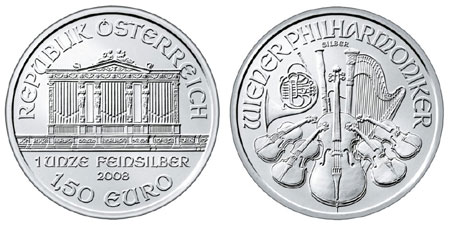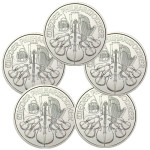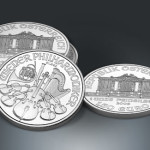Austrian Philharmonic Silver Coins
Disclosure: We are reader-supported. If you purchase from a link on our site, we may earn a commission. Learn more
Part of the world-renowned Philharmonic coin series, Austrian Philharmonic Silver coins (sometimes called “Silver Philharmonics”) are part of the best known, most widely available European precious metals. Philharmonics are the only minted bullion that carry a denomination in Euros. For their outstanding quality and purity, Silver Philharmonic coins are available for investments inside of an IRA. Here, you’ll learn everything you need to know about these fantastic coins. 
Development, Introduction and History
Austrian Philharmonic silver bullion coins are one of the most recent additions in the proud history of the Austrian Mint. This world famous mint first began producing precious metals coinage in 1194 A.D., and for over 800 years it has continuously produced some of the finest bullion in the world. The Austrian Mint was founded during the Holy Crusades. King Richard I of English (“Richard the Lionheart”) was captured and held hostage by the Austrian Duke Babenburg. Babenburg ransomed the monarch for 100,000 silver coins – half of which was used to found the Austrian Mint as a warehouse to store and protect valuable coins. The Philharmonic coins series was not introduced until 1989. Gold coins were authorized and backed by the Central Bank of Austria. The success of the gold coin series lead to the introduction of silver versions of the Philharmonics in 2008. These 1 troy ounce coins have become the most popular silver bullion in Europe. Unlike the Gold Philharmonics, Austrian Silver Philharmonics never carried a face value listed in Austrian shillings, since the country switched to euros in 2002 (six years prior to the release of Silver Philharmonics).
Austrian Silver Philharmonic Characteristics
Coin Design

Both the name and the design of Philharmonic coins pay tribute to the historic role that Vienna has played in the world of classical music. The silver series coins are very similar to the Austrian Philharmonic Gold series in appearance. The front, or “obverse”, of Austrian Silver Philharmonics display the Great Organ of the Golden Hall in Vienna’s Musikverein – the home of the Vienna Philharmonic Orchestra. The words REPUBLIK OSTERREICH (“Republic of Austria”) and 1 UNZE FEINSILBER (“1 ounce pure silver”) appear, along with the transactional value 1.50 EURO and the year of mintage. The rear, or “reverse”, side features a set of various musical instruments, representative of the Vienna Philharmonic Orchestra. Stretching along the top are the words WEINER PHILHARMONIKER (“Vienna Philharmonic”). The instruments depicted are:
- 1 cello
- 4 violins
- 1 Vienna horn
- 1 bassoon
- 1 harp
The images on both sides of the Philharmonic coins were designed by Thomas Pesendorfer in 1989.
Specifications
Silver Philharmonic bullion coins are minted in a single weight denomination – 1 troy ounce. All contain .999 silver purity (99.9% silver or “pure” silver). Other specifications include: Weight: 31.103 g Diameter: 37.0 mm Thickness: 3.2 mm Face Value: €1.5* *the face value was selected since €1 and €2 were both common denominations in euro coins, and €1.5 settles as a happy medium.
Silver Philharmonic Pricing
Each Silver Philharmonic coin carries a face value, or its transactional value when used as a currency. Austrian Philharmonic bullion coins are considered legal tender in the European Union, and their face value is dictated by law. The face value is largely symbolic, however. The actual investment value of Silver Philharmonics is typically much greater than the face value.

This is because the face value is completely unrelated to a coin’s intrinsic value, or value determined in the market. For Austrian Silver Philharmonics, this value is primarily determined by the spot price of silver. Silver prices fluctuate daily, and therefore the market prices for Silver Philharmonics will fluctuate daily as well. Check out our home page for live metal pricing.
Investing in Austrian Philharmonic Bullion Coin Through an IRA
All Austrian Silver Philharmonics are eligible to be placed inside of a self-directed IRA. By placing real, physical silver inside of an IRA, investors add diversification to their portfolio that is independent of the fluctuations of stocks and bonds. Since the spot price of silver tends to be much lower than gold, silver can be a more affordable alternative hedge for those interested in precious metals. The Internal Revenue Service (IRS) allows for specific types of IRAs to carry gold, silver, platinum and palladium bullion in a portfolio.
Sometimes referred to as a “precious metals IRA”, these IRA accounts may only contain bullion that meets the minimum purity requirements set forth by the IRS – such as Austrian Philharmonic Silver Series coins. Investors must make a minimum initial purchase of $5,000 worth of approved metals to establish a precious metals IRA. Each subsequent purchase of bullion must be at least $1,000.
Additionally, when an investor makes a purchase of Silver Philharmonics to add to an IRA, the IRS mandates that the metal be held in an approved precious metals depository. The depository is responsible for the safety and maintenance of the bullion. Those with existing IRAs can still open a precious metals IRA. They have the option of transferring or rolling over existing funds into a PM IRA.
Austrian Philharmonic Silver bullion coins are available for purchase directly from the Austrian Mint through their official website. International shipping may result in extra fees as your coins pass through customs. Additionally, collectors and investors can buy from dealers around the world, such as the American Precious Metals Exchange (APMEX).
Sign up to learn more. It's free!
If you're worried about the economy and want to learn tips on how to protect your retirement savings in case of another systemic collapse, sign up to our monthly newsletter now for free! We cover topics such as: precious metals investing, inflation, currency devaluation, national debt, the Fed's financial policies, world politics, and much more. Join now and we'll send you a free PDF report entitled “5 scams to avoid when investing in bullion gold & silver”



 Silver
Silver Gold
Gold Platinum
Platinum Palladium
Palladium Bitcoin
Bitcoin Ethereum
Ethereum
 Gold: $4,197.96
Gold: $4,197.96
 Silver: $58.33
Silver: $58.33
 Platinum: $1,647.16
Platinum: $1,647.16
 Palladium: $1,477.41
Palladium: $1,477.41
 Bitcoin: $90,144.29
Bitcoin: $90,144.29
 Ethereum: $3,051.28
Ethereum: $3,051.28